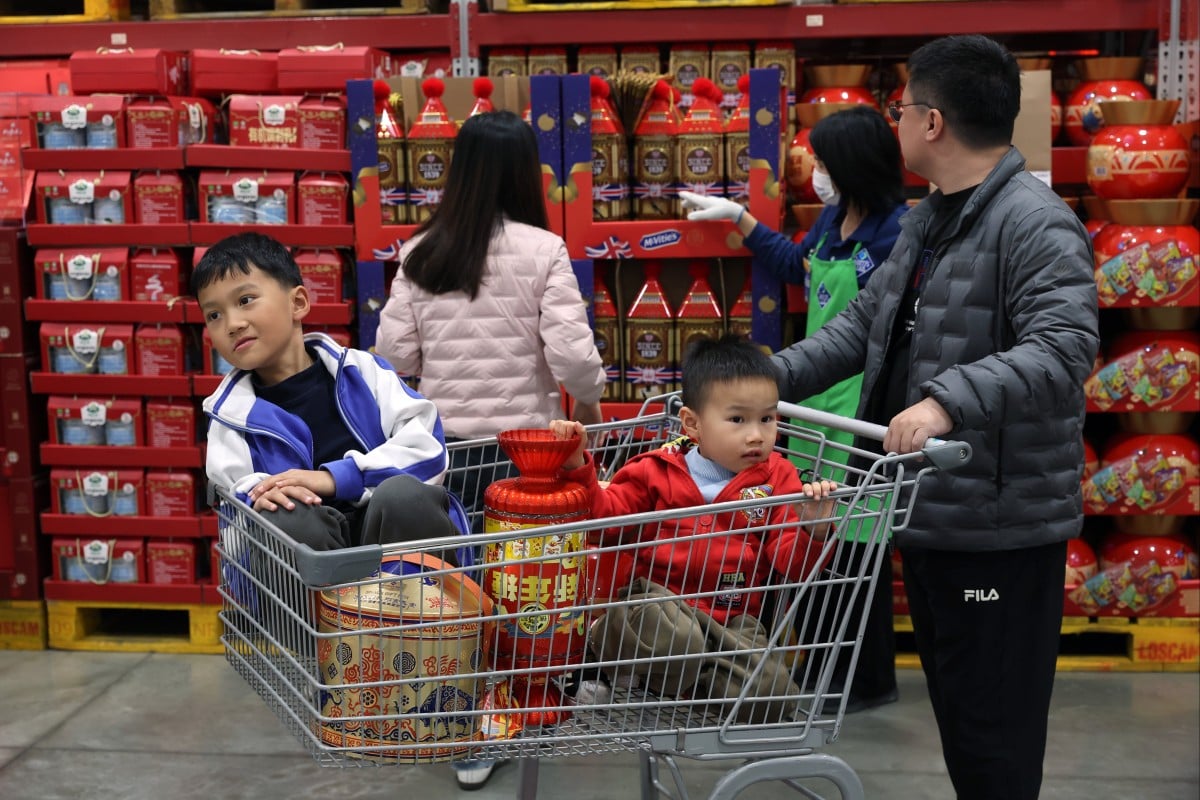
People are spending money more carefully, even trading items in group chats and flying to Japan and Singapore for lower prices.
 Many Hongkongers are travelling to Shenzhen to shop at bulk-buy stores like Sam’s Club. Photo: Edmond So
Many Hongkongers are travelling to Shenzhen to shop at bulk-buy stores like Sam’s Club. Photo: Edmond SoDeep Dive delves into hot issues in Hong Kong and mainland China. Our easy-to-read articles provide context to grasp what’s happening, while our questions help you craft informed responses. Check sample answers at the end of the page.
News: Hongkongers look to save money amid rising cost of living
-
Lower-income families have been especially affected by price increases in areas like food and transport
-
Consumer Council finds widespread ‘shrinkflation’ issue in which costs stay stable but the size of the product shrinks
An online mothers’ support group has helped Hong Kong guide dog trainer Margaret To and her family navigate the rising cost of living.
Thanks to the Lakesilver Moms group chat, she has found free baby clothes, toys, furniture, and even home appliances. Most items were second-hand, some nearly new.
“This has kept our family’s monthly expenses under HK$5,000,” she said. “In return, I’ve donated unused items to the group.”
To, 36, and her husband, who works in online marketing, became more mindful of their spending after their daughter was born around two years ago. They manage their expenses carefully; half of their HK$60,000 monthly income goes toward their flat’s mortgage.
“Everything in Hong Kong is getting more expensive,” she said, noting that restaurant prices have risen by at least 20 per cent.
Administrative manager Winnie Cheng, 35, has found a different way to cut costs – shopping abroad. She frequently visits Shenzhen and other destinations like Japan, South Korea, the UK, and Singapore, bringing an empty suitcase to stock up on essentials.
She takes short trips at least once a month, saving thousands of dollars by purchasing premium steak, organic fruit, and yogurt at lower prices. In Shenzhen, she shops at bulk-buy stores like Sam’s Club and Walmart.
“If you can get 10 croissants in Shenzhen for the price of one in Hong Kong, why not?” she said.
Like To and Cheng, many Hongkongers have adjusted to rising prices by exchanging second-hand goods, joining bulk-buy groups, or shopping and dining across the border, where costs are significantly lower.
Lower-income families have been especially affected by rising costs. Food and transport expenses make up a large portion of their budgets.
Last October, Hong Kong’s Consumer Council exposed widespread shrinkflation. They said that product sizes have been reduced by up to 30 per cent while prices remained unchanged. Some products even saw price increases of up to 26.2 per cent.
More Hongkongers are heading across the border to take advantage of cheaper prices on the mainland.
The impact is reflected in cross-border travel statistics. Hong Kong recorded a 48 per cent year-on-year surge in residents making trips to mainland China, reaching more than 93 million visits last year.
Staff writers
Question prompts
1. What strategies have Hongkongers used to cope with rising living costs?
(1) Purchasing only brand-new items to ensure their quality.
(2) Shopping abroad and bulk-buying essentials at lower prices.
(3) Joining groups to find second-hand goods.
(4) Relying solely on government subsidies for financial relief.
A. (1), (3) only
B. (2), (3) only
C. (3), (4) only
D. (2), (4) only
2. According to the news, how has Margaret To kept her family’s monthly expenses under HK$5,000?
3. Why does Winnie Cheng frequently travel abroad to shop? Explain using the news and glossary.
Graphic
Question prompts
1. What does the graphic show? How does it relate to the information presented in the news?
2. What are Hongkongers doing to save money while shopping? Explain using the news and glossary.
Glossary
second-hand: pre-owned or used goods, often bought at lower prices or through exchanges
bulk-buy stores: retail stores that sell goods in large quantities at a lower price per item
Sam’s Club: a membership-based warehouse store that sells products in bulk at discounted prices. It is owned by Walmart.
shrinkflation: when the size or amount of a product is reduced while prices remain the same or even increase
Answers
News
1. B
2. Margaret To has saved money by using a group chat for mothers to find free second-hand baby clothes, toys, furniture, and home appliances. In return, she donates unused items to the group.
3. Cheng visits destinations like Shenzhen, Japan, South Korea, the UK, and Singapore to purchase essentials at lower prices. She saves thousands of dollars on premium steak, organic fruit, and yogurt by shopping at bulk-buy stores like Sam’s Club, Ole, and Walmart. These stores do not have locations in Hong Kong.
Illustration
1. The graphic depicts “shrinkflation”. The price of sushi remains the same at HK$28, but the portion sizes decrease from 2023 to 2025. This aligns with the Hong Kong Consumer Council’s findings about shrinkflation, which showed that product sizes have decreased by up to 30 per cent while prices have remained unchanged or even increased.
2. Hongkongers are responding to rising costs and shrinkflation by shopping in mainland China, bulk-buying at warehouse-style stores like Sam’s Club, and exchanging second-hand goods. Additionally, some individuals, like Winnie Cheng, travel abroad to purchase essentials at lower prices, helping them save money on food and household expenses.
